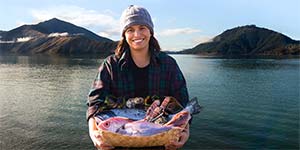Sanford Limited has generated a 25% increase in net profit after tax to $19 million for the six-month period that ended on March 31, 2017, compared to the same timeframe during the prior year.
The Auckland, New Zealand-headquartered seafood company reported revenue of $230.4 million for the first half of its financial year, up from $219.4 million during the like period in 2016. The positive result was achieved through increased prices of higher value, non-commodity products including toothfish, scampi and salmon, and shifting production plans towards higher value items such as fillets.
CEO Volker Kuntzsch described the performance as a “heartening validation of Sanford’s shift to focusing on non-commodity products, where greater value can be added through branding and a relentless approach to quality.”
 He added: “We have had a challenging first half in some ways. Adverse weather impacted operations on numerous occasions and pricing for commodity items such as jack and blue mackerel was lower than we would like, but our ability to still deliver a good result speaks to the resilience we have in this company, resulting from the diversity of our portfolio.”
He added: “We have had a challenging first half in some ways. Adverse weather impacted operations on numerous occasions and pricing for commodity items such as jack and blue mackerel was lower than we would like, but our ability to still deliver a good result speaks to the resilience we have in this company, resulting from the diversity of our portfolio.”
Sanford’s newest catching vessel, San Granit, the largest addition to its freezer fleet, took longer than expected to maximize fishing capacity because a number of technical adjustments had to be made to optimize it for New Zealand conditions.”
In New Zealand Sanford operates a fleet of 11 Timaru-based vessels that freeze and pack the catch onboard as soon as it is landed. Three are sister vessels – 64-meter freezer trawlers all built in the same yard in Norway in the early 1990’s and extensively upgraded in 1997 and 1999. The company also operates a Norwegian-built longline freezer vessel and six specialist scampi vessels.
 Sanford’s Timaru-based San Granit fishing vessel freezes and packs catches onboard while at sea.Overall, the wild catch business has performed well, with the volume of fish caught increasing year-on-year by 1,600 tons. The longline and deepwater freezer vessels contributed the majority of tonnage, while the inshore fleet was often hampered by poor weather.
Sanford’s Timaru-based San Granit fishing vessel freezes and packs catches onboard while at sea.Overall, the wild catch business has performed well, with the volume of fish caught increasing year-on-year by 1,600 tons. The longline and deepwater freezer vessels contributed the majority of tonnage, while the inshore fleet was often hampered by poor weather.
The company is committed to New Zealand as a market for its seafood. The home market was the destination for NZ $79.7 million worth (approximately US 56 million) of Sanford product during the past six months, compared to NZ $68.7 million (about US $48.5 million) for the same period in 2016.
Aligned with this is the new approach to branding at Sanford. Development work continued during the first half of the year on premium labels, including the Big Glory Bay King Salmon brand, as well as farmed Bluff Oysters and Greenshell Mussels from Stewart Island. Several high end New Zealand restaurants have recently welcomed the brand.
Justine Powell, Sanford’s general manager for marketing and consumer activities, commented: “We have gone in a very short time from servicing no Auckland restaurants to supplying approximately one third of the top 50 eateries. Clearly this is an exciting start and we feel there are more great things to come.”





